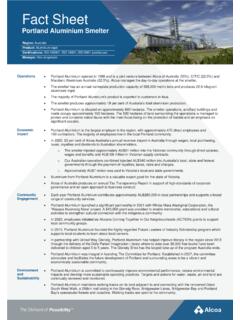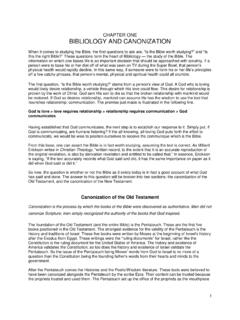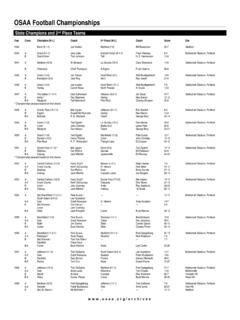Transcription of Cost Analysis of Bicycle Facilities
1 This report was supported by the Robert Wood Johnson Foundation, through its Active Living Research program. Cost Analysis of Bicycle Facilities : Cases from cities in the portland , OR region FINAL DRAFT Lynn Weigand, Nathan McNeil, Jennifer Dill, June 2013 Cost Analysis of Bicycle Facilities : Cases from cities in the portland , OR region Lynn Weigand, PhD, portland State University Nathan McNeil, MURP, portland State University* Jennifer Dill, PhD, portland State University *corresponding author: portland State University Center for Urban Studies Nohad A. Toulan School of Urban Studies & Planning PO Box 751 portland , OR 97207-0751 June 2013 All photos, unless otherwise noted, were taken by the report authors.
2 The authors are grateful to the following peer reviewers for their useful comments, which improved the document: Angie Cradock, ScD, MPE, Harvard Chan School of Public Health; and Kevin J. Krizek, PhD, University of Colorado Boulder. Any errors or omissions, however, are the responsibility of the authors. CONTENTS Executive Summary .. i Introduction .. 3 Bike 7 Wayfinding Signs and Pavement Markings .. 11 Flow, Volume, and Speed Management .. 14 Intersections and Crossings: Signage and Pavement Markings .. 18 Intersections and Crossings: Curbs and Medians .. 21 Intersections and Crossings: Signals and Beacons .. 23 Bicycle Boulevards .. 28 Cycle Tracks .. 31 Bicycle Parking Facilities .. 36 Conclusions .. 38 i EXECUTIVE SUMMARY Overview As communities nationwide are faced with declining transportation revenues and increased demand, Bicycle Facilities can offer a way to increase the capacity of the existing infrastructure at a lower cost than traditional road projects.
3 Bicycling instead of driving for shorter distances can help reduce traffic congestion by getting cars off the roadway, while promoting physical activity and better health for the individual. However, this potential can be overlooked as local officials are often unaware of the need to enhance the Bicycle network to increase ridership, along with the relatively low cost to improve and expand the network. This study was undertaken to provide policy-makers with objective information on the true costs of Bicycle Facilities ; to give transportation planners and engineers cost data to develop realistic plans and cost estimates; and, to help active transportation advocates make the case to the public and to elected officials for the economic benefits of Bicycle Facilities and cost savings over other infrastructure.
4 We worked with staff at the portland regional government (Metro) and ten cities in the metropolitan region to identify and document costs for a range of recently-completed Bicycle infrastructure projects. Key Findings This study documented the costs associated with installing various Bicycle Facilities on existing streets, along with descriptions and photos of each facility type. For each type of Bicycle facility there are a range of possible costs, determined in part on whether the change is a simple intervention or more complex redesign, and what level of planning or engineering the physical and political context require. In general, we found that costs associated with design and construct of Bicycle infrastructure improvements are relatively low when compared to similar lengths of roadway projects.
5 For example, the City of portland calculated that the city s entire Bicycle network, consisting of over 300 miles of bikeways would cost $60 million to replace (2008 dollars), whereas the same investment would yield just one mile of a four-lane urban In addition, Bicycle Facilities can often be combined with other roadway improvements to take advantage of economies of scale. For example, Bicycle lanes can often be added to streets as part of planned maintenance or re-striping projects at a cost of $1 -5 per foot (excluding right of way acquisition and engineering costs). Bicycle boulevards, which are through-routes on streets with low traffic volumes and speeds, typically include a range of improvements to calm traffic and improve conditions for cycling.
6 Depending on the context and magnitude of the project, Bicycle boulevards generally cost between $ and $ per foot. Table 1 provides an overview of our cost findings for a variety of Bicycle infrastructure. This study provides objective information on the true costs of Bicycle Facilities that can be used by local policy makers, transportation planners and engineers, and advocates to support the cost effectiveness of this mode of transportation, and to develop realistic plans to increase the amount of local Bicycle infrastructure. 1 City of portland Bureau of Transportation, How portland Benefits from Bicycle Transportation. Accessed online 11/15/2011 at ii However, we also found that there is a need for improved cost tracking.
7 Costs for Bicycle Facilities are not easy to capture for several reasons: they often occur as part of a larger multi-modal roadway projects, and Bicycle -related costs are not tracked separately; in addition, the facility costs may reside in several departments or agencies, commonly planning and engineering, and not always aggregated at the end of the project. Table 1 Cost Overview Category Facility Type Cost Bike Lanes Line/stripe removal $ Bike Lanes $ $ Buffered Bike Lane $2-$ Bike Lane Stencil $250-$270/stencil Signs and Markings Remove existing sign $129/sign Remove and Reinstall existing signs $140/sign New stop sign $150/sign Wayfinding sign $200-$440/sign Sharrow $250-339/sharrow Flow, Volume, Speed Management Bike-Thru Median $721/ft Speed Hump $2,500-$2,800/hump Chicanes $5,000/chicane Traffic Circles $20,000/circle Intersections and Crossings Pedestrian and Bicycle crossing signs $200/sign Crosswalk $1,000/crosswalk Raised Crosswalk $3,500/crosswalk Two-stage turn queue box $1,000/box Bike Box $5,000/box Standard Curb Extension $15.
8 600/extension Green Curb Extension $28,397/extension Refuge Island $1,700-$21,580/island Rectangular Rapid Flash Beacon $7,500-$20,250/RRFB Bicycle Signal Head $5,000/signal Bicycle Loop Detection $6,630-$7,730/lane Bicycle Signal Push Button Actuation $3,000/pole Complete Bicycle Signal Retrofit $52,201/signal HAWK Signal $150,000/intersection Full Signal $140,000-$250,000/intersection Bicycle Boulevards Bicycle Boulevard $ $ Cycle Tracks At Grade Cycle Track $ One Way Raised Cycle Track $ Two Way Raised Cycle Track $188-$698/ft End of Trip Facilities Bike Racks $200/rack Bicycle Corral $3,000/corral 3 INTRODUCTION Background Bicycling is rapidly growing in popularity as a transportation choice for many shorter trips because of its environmental, economic and health benefits.
9 Studies have found that safe and convenient cycling infrastructure is an important element to increase the mode share of trips taken by bicycle2. However, many American cities have been built to facilitate automobile travel, and are not conducive to bicycling. Even as local government officials often recognize the importance of providing Bicycle Facilities , the perception is often that Bicycle Facilities are expensive and serve only a small minority. In portland , as bikeway miles increased almost four-fold from 79 miles in 1991 to 307 in 2011, counts of cyclists crossing major bridges into downtown increased over six-fold to 18,257 (accounting for over 16% of daily traffic over those bridges).3 According to the Census Bureau, over 6% of workers regularly commuted by Bicycle in the city in 2011, compared to about 1% in Investing in Bicycle Facilities can be a very good value for cities.
10 Research shows that constructing Bicycle Facilities has the potential to increase the number of Bicycle trips, which over time can reduce the need for more costly road expansion projects. The City of portland had made substantial efforts to document the value of its investment in Bicycle transportation, calculating the portland s entire Bicycle network, consisting of over 300 miles of bikeways would cost $60 million to replace (2008 dollars), whereas the same investment would yield just one mile of a four-lane urban freeway5 portland also notes that increases in economic activity and population between 1991 and 2008 would have overwhelmed the capacity of the city s existing bridges had the related increase in mobility needs been borne solely by auto traffic.





